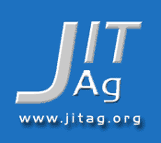Submission Guidelines
The Journal of Information Technology in Agriculture (JITAg) is a refereed publication of WFITA.
JITAg expands and updates the research and knowledge base for Agricultural IT professionals and other adult educators to improve their effectiveness. In addition, JITAg serves as a forum for emerging and contemporary issues affecting food, fibre production, and natural resources.
JITAg is written, peer-reviewed, edited, and published by agricultural IT professionals, sharing with their colleagues successful educational applications, original and applied research findings, scholarly opinions, educational resources, and challenges on issues of critical importance to agriculture.
Authors submitting articles to JITAg must follow the guidelines in this document. Submissions that deviate from these guidelines will be returned to the corresponding authors for changes. Because the guidelines are updated as appropriate, authors should check them again before they submit their articles.
JITAg is published on the World Wide Web. Authors should prepare their articles with the Web and on-screen reading in mind. This means, among other things, shorter paragraphs and more bullet and numbered lists than are conventional in more traditional, on-paper journals.
Help for JITAg Authors offers additional information on writing for JITAg . Authors are strongly encouraged to visit this site.
Journal Sections/Article Categories
JITAg accepts submissions in the following categories. Authors should
note the differences among the article categories, and the corresponding
authors should indicate the category of the article they are submitting.
Feature (reviewed by three reviewers): Discuss concepts and research findings of particular interest and significance to agricultural IT professionals and to the knowledge base, methodology, effective practice, and organization. Emphasize implications of IT. Maximum length: 3,000 words, plus tables, graphics, and abstract.
Research in Brief (reviewed by three reviewers): Summarize research results of importance to U.S. Extension professionals. Maximum length: 2,000 words, plus tables, graphics, and abstract.
What's the Difference? A Feature focuses on the implications of the data or concepts for as wide an audience of agriculture professionals as possible (hence, the "extra" 1,000 words). A Research in Brief focuses more on the data, itself, and the methods used to gather it. A Feature is broader in scope and implication. A Research in Brief is more specific and localized.
Ideas at Work (reviewed by one reviewer): Describe novel ideas, innovative programs, and new methods of interest to agricultural professionals. Maximum length: 1,000 words (including abstract), plus tables and graphics.
Tools of the Trade (reviewed by the editor): Report on specific materials, books, techniques, and technology useful to agricultural professionals. Maximum length: 1,000 words (including abstract), plus tables and graphics.
What's the Difference? An Ideas at Work focuses on what is novel. A Tools of the Trade focuses on what is useful. An Ideas at Work focuses on an idea. A Tools of the Trade focuses on a thing.
Commentary (reviewed by the editor): Offer a challenge or present a thought-provoking opinion on an issue of concern to agricultural IT professionals. Initiate discussion or debate by responding to a previously published JITAg article. Maximum length: 1,500 words, plus abstract.
What's the Difference? The difference between a Commentary and the
other types of JITAg articles is challenge, immediacy, and conviction.
Submission Formats & Procedure
Articles for JITAg must be written in English.
JITAg accepts submissions in electronic format only and from a single
designated corresponding author. A submission must be a single file using the JITAg template. A deatiled description of the Format can be found here.
Authors who have questions can contact the editor.
Submission Procedures
Review Procedures
Help for JITAg Authors
Q&A for Authors

